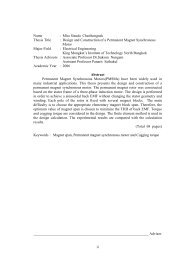a multi-objective bisexual reproduction genetic algorithm for ...
a multi-objective bisexual reproduction genetic algorithm for ...
a multi-objective bisexual reproduction genetic algorithm for ...
Create successful ePaper yourself
Turn your PDF publications into a flip-book with our unique Google optimized e-Paper software.
40<br />
The Grid system is only used by a client in the central office to start the<br />
scheduling engine that then activates the grid system. The grid system is also a 3-tier<br />
architecture of the following: Client, Commodity Grid (CoG), and Globus Grid<br />
Environment (Grid).<br />
The Client tier is the interface between users and the grid system. It is<br />
responsible <strong>for</strong> receiving command to run the scheduling engine.<br />
The CoG tier acts as an interface between the Grid and Client tier. Using the<br />
facilities provided by the API, the CoG is able to allow secure file transfers and also<br />
takes the responsibility of job scheduling and monitoring the status of jobs. There is<br />
one job <strong>for</strong> centralized course scheduling, and many other jobs <strong>for</strong> decentralized<br />
course scheduling. When a job needs to be per<strong>for</strong>med, the CoG will look <strong>for</strong> available<br />
nodes to assign it to. The Management and Discovery Service (MDS) provided by the<br />
Globus Toolkit will provide in<strong>for</strong>mation about the available nodes within the Grid.<br />
Next, it checks and locates the sequence data to available machines (nodes).<br />
Security (GSI) and reliability is important when transferring data to various nodes<br />
within the Grid. In order to provide <strong>for</strong> such requirements, the Globus Toolkit<br />
provides a data management component, known as Grid Access to Secondary Storage<br />
(GASS), <strong>for</strong> secure and reliable data transfers. It uses the GridFTP protocol to<br />
facilitate the checking and transport of data files.<br />
The CoG tier monitors the progress of each job and polls regularly to check if<br />
the jobs are finished. The Grid Resource Allocation Manager (GRAM) provides the<br />
necessary services <strong>for</strong> these processes. Once compiled, the results will be stored into<br />
the database, and their status will be shown to the Client.<br />
3.5 The Database Design<br />
In the database design, we present an entity relation diagram, shown in Figure<br />
3-5. This design also helps us understand more clearly the system requirements.<br />
Data relations between the entities in the above diagram are very important.<br />
Since the course scheduling programs will not work directly on the database, it works<br />
on the data structures instead. There<strong>for</strong>e, the data and its relations need to be loaded<br />
from the database into the corresponding data structures be<strong>for</strong>e scheduling. The













